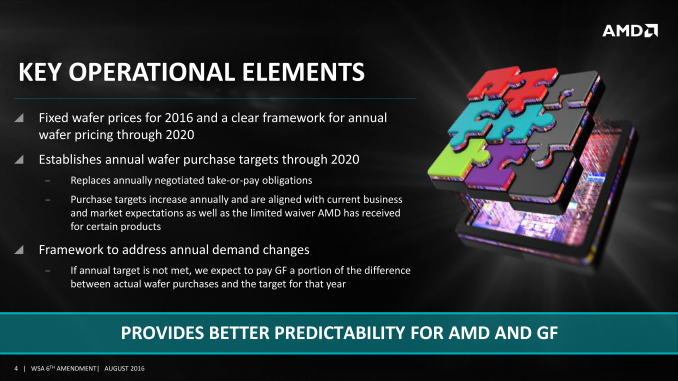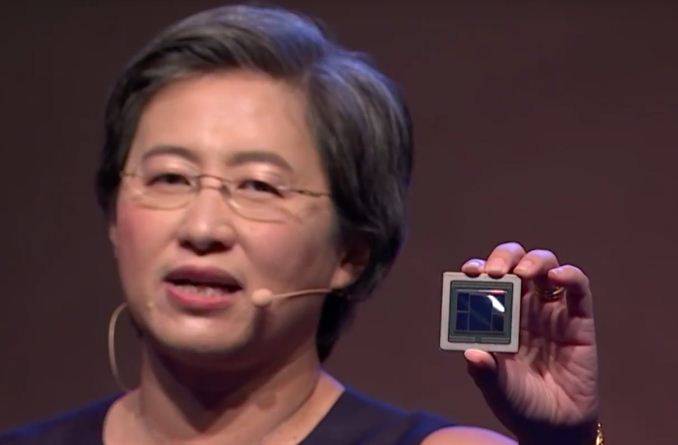AMD's 7nm CPUs & GPUs To Be Fabbed by TSMC, on Track for 2018 - 2019
by Ryan Smith & Anton Shilov on August 27, 2018 6:40 PM EST- Posted in
- Semiconductors
- CPUs
- AMD
- GlobalFoundries
- GPUs
- TSMC
- Vega
- Navi
- Zen 2

With the announcement that its long-time manufacturing partner (and outright former fab) GlobalFoundries is dropping out of the race for bleeding-edge manufacturing nodes, the second big question of the day has been what this means for AMD. For all intents and purposes, AMD and GlobalFoundries have been tied at the hip since GloFo was spun off from AMD back in 2009, and consequently GloFo has always been AMD’s fab of choice for CPUs, and more recently GPUs. So with GlobalFoundries’ changes to their process development plans, AMD is outlining their new partnerships and manufacturing plans.
In short, AMD is now shifting over the bulk of their bleeding-edge development to TSMC. The company is careful to note that they “intend to focus the breadth” of their 7nm production at TSMC rather than all 7nm production – leaving open the possibility of using TSMC rival Samsung in the future – but the message is clear that we should expect AMD’s major 7nm products to be fabbed out of TSMC now that GlobalFoundries is no longer an option.
TSMC being AMD’s new bleeding-edge partner should of course come as no surprise, as TSMC has been the fab AMD has fallen back on for other projects in the past. TSMC was until the most recent generation the fab AMD used for their GPUs, and it’s where their semi-custom APUs for Microsoft and Sony have been made. Meanwhile AMD and TSMC have already previously announced that some of AMD’s forthcoming 7nm products, including their 7nm Vega and “Rome” EPYC CPU would be fabbed by the Taiwanese foundry. So today’s announcement is largely confirmation that AMD is going to continue down this path, with most (if not all) of their other planned 7nm products ending up at TSMC as well.
As it stands then, AMD’s plans remain largely unchanged. AMD’s 7nm Vega GPU has been successfully taped out, and it is currently sampling among AMD’s customers with a commercial launch towards the end of this year. Then in 2019, AMD intends to release its CPUs featuring its Zen 2 microarchitecture. These processors will also be fabbed by TSMC and the chip designer has already received the first working silicon.
Farther out, AMD’s announcement also confirms that their upcoming Navi architecture GPUs, which are also planned for 7nm, will be fabbed at TSMC. Though AMD has not disclosed any timeframes regarding these GPUs and whether any of them have been taped out.
Overall, AMD seems reasonably happy with the current state of affairs, stating that “Our work with TSMC on their 7nm node has gone very well and we have seen excellent results from early silicon.” As a close GlobalFoundries customer, I have to imagine that AMD was the first such customer informed of these plans, so they’ve had the most time to adjust their internal plans. None the less, the company sees it as win for their “flexible foundry” strategy, and as a result, they do not expect any changes to their product roadmaps despite the foundry changes.
That said, while AMD seems to be handling this well, this isn’t a feint on their part, and that they’ve had to make changes behind the scenes. The company has confirmed to us that they had started development of a chip to be made using GlobalFoundries' 7LP process technology, but this one had not been taped out yet (it was on track for a Q4 tape out, according to GF). So we will be seeing products that weren’t originally intended for TSMC.
As for AMD’s GlobalFoundries relationship, the company will be continuing to work with GlobalFoundries for some time to come. GloFo is still AMD’s fab for their current Vega, Polaris, and Zen/Zen+ chips, and AMD will continue making chips there. Furthermore should AMD decide to start on any new chips that don’t require a bleeding-edge manufacturing process (e.g. a chipset), then GlobalFoundries is still an option.

To be renegotiated: AMD's most recent GF Wafer Share Agreement
The biggest remaining question then will be what this means for AMD and GlobalFoundries longstanding Wafer Share Agreement (WSA), which has kept the two companies bound together tightly and required that AMD do most of its manufacturing at their former fab. Today’s announcement from GlobalFoundries and AMD has confirmed that the two companies will be renegotiating the WSA – presumably a requirement should GloFo no longer intend to offer bleeding-edge nodes – though to what extent remains to be seen. AMD by their own admittance is betting very heavily on 7nm products, so it’s not clear whether the company is going to need all that many wafers from GlobalFoundries in a couple years’ time. In the meantime, AMD does not believe it is going to need any WSA with TSMC.
Related Reading:
- GlobalFoundries Stops All 7nm Development: Opts To Focus on Specialized Processes
- AMD “Rome” EPYC CPUs to Be Fabbed By TSMC
- AMD Demos 7nm Vega GPU: Betting Big on Machine Learning for Radeon Instinct; Shipping This Year
- The AMD Threadripper 2990WX 32-Core and 2950X 16-Core Review
- More Details About the ZhongShan Subor Z+ Console, with Custom AMD Ryzen SoC
- The AMD 2nd Gen Ryzen Deep Dive: The 2700X, 2700, 2600X, and 2600 Tested
Source: AMD











28 Comments
View All Comments
eastcoast_pete - Tuesday, August 28, 2018 - link
A lot of this doesn't make sense. AMD claims that its 7 nm chips will be fabbed by TSMC; on the other hand, quite reliable industry sources and observers state pretty definitively that at least 75% of TSMC's 7 nm capacity will go to Apple, at least in 2018, and likely forward, with the remainder essentially all for mobile SoCs from Huawei, Qualcomm, plus some cryptomining ASICs. For example, this https://www.eetimes.com/document.asp?doc_id=133361... in the eetimes. So, either TSMC can ramp up its 7 nm fab A LOT, or AMD will only ship a small number of some EPYCs on 7 nm so they can say they shipped 7 nm chips, or they are just giving us story right now. I believe AMD's CPUs and GPUs will be on 12 nm for another two years or more, unless they can make a deal with Samsung, and Samsung gets its 7 nm process geared up for large transistor counts. Right now, I'd need to see an official TSMC announcement of a large volume deal with AMD for 2018/19 before I buy AMD's story, and I am not the only one.vladx - Wednesday, August 29, 2018 - link
Lmao good luck competing with Qualcomm and Huawei, two much richer companies, for fab capacity.eva02langley - Wednesday, August 29, 2018 - link
TSMC doesn't have a lot of X86 chips in the making and especially none of them are on 7nm. It was a clear indicative that they are interested because of their lack of experience in the field.I don't see a huge delay happening anytime soon. Like stated before, AMD was aware of this for a long time and they had plan their root way before EPYC ROME at TSMC.
vladx - Thursday, August 30, 2018 - link
X86 or ARM doesn't matter, both use same wafers to be fabbed. In fact the situation is quite worse for x86 because desktop CPUs have much bigger die size u usually.So yeah, AMD will definitely have problems getting enough fab capacity for their 7nm products especially with needing it for both CPUs and GPUs.
0ldman79 - Wednesday, August 29, 2018 - link
So AMD might need a foundry in the near future and GloFo sounds like it has hit a snag with 7nm, which it's only going to get harder from here on.I thought Global Foundries were already working with IBM on 5nm?
Wouldn't it be crazy if AMD wound up contracting Intel to manufacture 7nm AMD CPUs?
eastcoast_pete - Wednesday, August 29, 2018 - link
I don't think Intel would manufacture AMD's chips. However, I wouldn't be surprised if Intel swoops in, takes the tech, the IP, the equipment (mucho dinero DUV ASML kit!) and key personnel of GloFo's hands for cheap, and gets IBM's blessings (any buyer would need that, IBM owns key IP) in return for manufacturing IBM's mainframe CPUs and other silicon in 7 nm. An Intel acquisition of the tech (or the entire foundry?) would also take care of the Trusted Foundry problem.Targon - Thursday, August 30, 2018 - link
When AMD had their lawsuit with Intel, AMD should have forced Intel to split off their fabs as a part of the settlement. That would have allowed AMD to use the Intel fab process without it being a part of Intel.eastcoast_pete - Wednesday, August 29, 2018 - link
GloFo's announcement was pretty clear that they will, at least for now, seize all development of 7 nm and lower nodes, so that includes 5 nm. I believe that this "we'll make our chips on 7 nm at TSMC" announcement by AMD is a mix of whistling in the dark, trying keep to some analysts happy (for how long?), and might even be somewhat of an attempt to keep AMD's personnel calm. Let's face it: the GloFo announcement was a surprise for AMD (and most everybody else), and AMD really got screwed by GloFo's sudden exit from 7 nm. GloFo was supposed to be their 7 nm volume supplier, but apparently the volume wasn't enough for GloFo to keep plowing billions of $$$ into getting fab 8 up-and-running on 7 nm DUV.